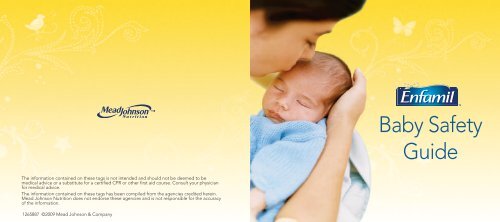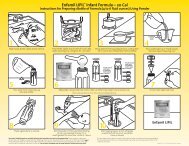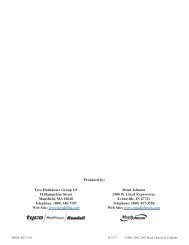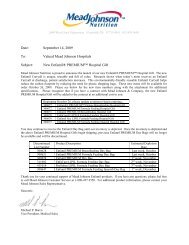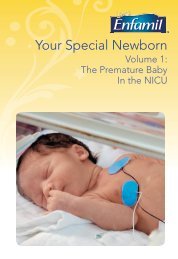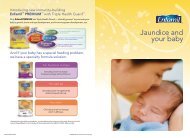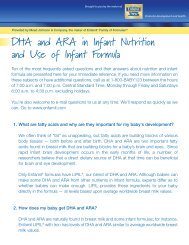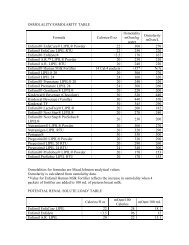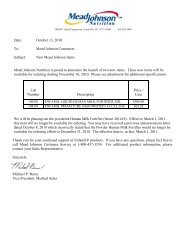You also want an ePaper? Increase the reach of your titles
YUMPU automatically turns print PDFs into web optimized ePapers that Google loves.
<strong>Baby</strong> <strong>Safety</strong><strong>Guide</strong>The information contained on these tags is not intended and should not be deemed to bemedical advice or a substitute for a certified CPR or other first aid course. Consult your physicianfor medical advice.The information contained on these tags has been compiled from the agencies credited herein.<strong>Mead</strong> <strong>Johnson</strong> <strong>Nutrition</strong> does not endorse these agencies and is not responsible for the accuracyof the information.1265887 ©2009 <strong>Mead</strong> <strong>Johnson</strong> & Company
Basic First Aid Tips*FOR INFANTS FROM BIRTH TO ONE YEARFor A Conscious Choking InfantIf A Choking Infant Becomes UnconsciousCHOKING123Check the scene and theinfant...Identify yourself andask the parent or guardian ifyou can help.If the infant cannot cough,cry or breathe...Havesomeone else call 911 or thelocal emergency number.Give 5 back blows with theheel of your hand betweenthe shoulder blades.456Position the infant face-upon your forearm with thehead below the shoulders.Place two fingers verticallyon the center of thebreastbone just below thenipples and give 5 chestthrusts...Repeat steps 3–5 until theforeign object is coughedup or the infant becomesunconscious.123Open the airway by gentlytilting the head backand lifting the chin.If the infant is notbreathing, give 2 slowbreaths to make thechest rise.If breaths do not go in, tilt theinfant’s head further back andgive 2 rescue breaths again.If breaths still do not go in,give 5 chestcompressions.456Look for any object in theinfant’s mouth.Remove it withyour pinkyfinger (only ifyou can see theobject).Give 2 rescue breaths.Repeat steps 3, 4, and 5 untilair goes in, the infant startsto breathe,coughs forcefully,or help takes over.CHOKINGIf the infant becomes unconscious, follow directions on the next page.*These tips do not replace taking an American Red Cross course.For course information, contact your local American Red Cross unit.
If An Infant Appears UnconsciousSTOPS BREATHING123Flick the bottom of the infant’sfoot. Do not tap or shake aninfant. If there is no response,have someone call 911 or thelocal emergency number.If you’re alone, give care for2 minutes, then call.Open the airway by gentlytilting the head back andlifting the chin.Check for breathing. Look, listen,and feel for breathingfor about 10 seconds.4567If the infant is not breathing,keep the head tilted, seal yourmouth around the infant’s mouthand nose. Give 2 slow breaths tothe make the chest rise gently.If pulse is present, give 1 slowbreath every 3 seconds, forabout 2 minutes, then recheckthe pulse and breathing.Continue care until help arrives.Check the pulse inside theupper arm for about 5–10seconds. If there is no pulse,do CPR (30 quick chestcompressions then 2 breathsand repeat).Open Airwayand BreathingPulseCheckChest ThrustandChest PumpSTOPS BREATHING
PoisoningWoundsBurnsPOISONINGSome signs of possible poisoning:• child is vomiting or having troublebreathing• unusual odors, flames, smoke• overturned or chewed plants• open or spilled containers ormedicine bottles, or an openmedicine cabinet123Check the scene for safety.Care for life-threateningproblems first.Call 911, or the local emergencynumber, or the local poisoncontrol center at 800-222-1222and follow instructions.Do not induce vomiting.Keep wounds that have broken theskin surface covered and clean. Tohelp prevent infection, wash yourhands before and after care. Wearmedical gloves if possible. Keep theinfant warm and watch carefully forchanges in alertness.123For severe bleeding, call 911 orthe local emergency number.To control bleeding, cover thewound with dressing, press yourhand firmly against the wound,cover the wound with a bandage.If an arm or leg is bleeding, (afterapplying dressing and pressure),raise the limb above the level of theheart. Cover the limb with a bandage.If still bleeding, press pressurepoint (inside upper arm or whereleg bends at the groin area).Except for very minor ones,burns are serious for infants.1 Call 911 or the localemergency number.2 Soothe the burn with cool,running water; do not placethe infant in tub full of water.3 Cover burns with steriledressing.4 Keep infant from beingchilled or overheated.WOUNDS & BURNS
FeverWhen Your <strong>Baby</strong> CriesFEVEREveryone’s temperature tends to belower early in the morning andhigher between late afternoon andearly evening.A child has a fever when theirtemperature is at or above one ofthese levels:• 100.4°F (38°C) measured in thebottom (rectally)• 99.5°F (37°C) measured in themouth (orally)• 99°F (37.2°C) measured under thearm (axillary)Call a doctor if your child• Is younger than 3 months old andhas a rectal temperature of 100.4°F(38°C) or higher• Is 3–12 months old and has a feverof 102.2°F (39°C) or higher• Is under age 2 years and has a feverthat lasts longer than 24–48 hours• Is older and has a fever for longerthan 48–72 hours• Has been having fevers come andgo for up to a week or more, evenif they are not very high• Recently had an immunizationCall 911 if your child has a fever and:• Cannot be awakened easily orat all• Has difficulty breathing, even aftertheir nose is cleared• Has blue lips, tongue, or nails• Refuses to move an arm or legBabies cry when they are hungry,wet, tired, want company, ormaybe just at a certain time of theday or night. When your babycries, here are some things to try:• Feed your baby slowly, pausingto burp the baby often.• Check the diaper and change it,if needed.• Hold your baby against yourchest and walk or rock him.• Sing to your baby or play softmusic.• Take your baby for a ride in astroller or car.If the crying persists, or if there aresymptoms of illness, there may bea medical reason for the fussiness,and you should consult yourbaby’s doctor.No one likes to listen to a baby cryfor a long time, but BE PATIENT. Ifyou have had all you can take, putthe baby in a crib, make sure he issafe, and close the door. You cancheck on him every 5–10 minutes.If possible, have someone else youknow you can trust take care ofyour baby for a while.Never hold or pick up a babywhen you feel angry.TELL EVERYONE WHO TAKESCARE OF YOUR CHILD NEVER TOSHAKE HIM FOR ANY REASON.Each year, hundreds of infants areseriously injured or even killed bybeing shaken.For more information, contact:www.shakenbaby.com/Childhelp USA 1-800-4-A-CHILDCRYING BABY
PREVENTING ABDUCTIONS34should never include the family’shome address and be limitedto the parents’ surname(s). Ingeneral, birth announcementsin newspapers are not endorsed bymost experts.Use caution in creating websites foryour infant or posting photographsof your infant on websites. Whendoing so limit access to those youknow personally and trust. To limitanyone else’s potential misuse of aphotograph of your infant, carefullyconsider anyone’s request to takea picture of your infant and onlyshare photographs of your infantwith those you know personallyand trust.The use of outdoor announcementssuch as signs, balloons, large floralwreaths, and other lawn ornamentsare not recommended to announcea birth because they call attention5to the presence of a new infant inthe home.Only allow persons into your homewho are well-known by the mother.It is ill advised to allow anyone intoyour home who is just a mere orrecent acquaintance or known onlyonline such as in social-networkingwebsites, chatrooms, and forums,especially if met briefly since youbecame pregnant or gave birth toyour infant.There have been several caseswhere an abductor has made initialcontact with a mother and infant inthe healthcare-facility setting andthen subsequently abducted theinfant from the family home. Ifanyone should arrive at the homeclaiming to be affiliated with thehealthcare facility where the infantwas born or other healthcareprovider, remember to follow the6procedures outlined in number1 on the previous page.A high degree of diligence shouldbe exercised by family memberswhen home with the infant. Thebottom line is, the infant’s family isthe domestic security team, andall family members should besensitive to any suspicious visitors.If you must take your infant out,whenever possible, take a trustedfriend or family member with youas an extra set of hands and eyesto protect and constantly observethe infant. Never leave a childalone in a motor vehicle. Alwaystake the child with you. Never letsomeone you don’t know pick upor hold your child. There havebeen cases in which initial contactwith a mother and infant wasmade in other settings such asshopping malls or bus stations.7For your records to take home,have at least one colorphotograph of your infant (full,front-face view) taken along withfootprints and compile a completewritten description of your infantincluding hair and eye color,length, weight, date of birth, andspecific physical characteristics.To obtain theseguidelines andNCMEC’s ReprintPolicy, please callNCMEC at1-800-THE-LOST ®(1-800-843-5678)or visitwww.missingkids.com.PREVENTING ABDUCTIONS
Checklist For Crib <strong>Safety</strong>CRIB SAFETY12Slats should be 2 3/8” apart orless, and none should bemissing. There should be nodecorative cutouts a babycould put a hand or footthrough.Mattress should fit snugly, lessthan 2 fingers’ width betweenthe mattress and sides, sincebabies can suffocate in gapsbetween the mattress and theside of the crib. This applies toportable cribs as well—so,don’t add another mattress,pillow, comforter or paddingto a portable crib.3 When leaving a baby in the 5crib, make sure the sides areraised and locked.4Remove pillows, pillow-likebumper pads, quilts,comforters, sheepskins, stuffedtoys, and other soft productsfrom the crib. These productsmay cause infants to re-breatheexhaled air and suffocate. Makesure the baby’s head remainsuncovered during sleep.6Consider using a sleeper as analternative to blankets, and noother covering. If using ablanket, put baby with its feetat the foot of the crib. Tuck athin blanket around the cribmattress, only as far as thebaby’s chest.Never tie toys or pacifiers tothe crib, and make surehanging crib toys (mobiles, cribgyms) are out of baby’s reach.Hanging crib toys should beremoved when the baby is5 months old or first beginsto push up on his or her handsand knees.CRIB SAFETYFor additional importantcrib safety information, visit www.keepingbabiessafe.org/safety_cribs.shtml
A Quick Car Seat CheckupCAR SEATThis information is provided by the National TransportationHighway <strong>Safety</strong> Administration. For more important informationsee: www.nhtsa.gov.Following these simple guidelines may save your child’s life.• Place your child in thecar seat in the backseat of your vehicle.The back seat is thesafest place during ahead-on collision, whichis the most seriousand commontype of crash.• If your child is under12 months and weighs less than20 pounds, the safety seat shouldface the rear of the vehicle;after his first birthday and past20 pounds, he can ride the car seatfacing forward in the back seat.• Read your vehicle owner’smanual and the child seatinstructions to assist in properlyinstalling the child seat.• As of September 2002, new cars,mini-vans, and light trucks comeequipped with the LowerAnchors and Tethers for Children(LATCH) System. LATCH is asystem that makes child safetyseat installation easier—withoutusing the seat belts.• The top tether strap is locatedat the top rear of convertiblechild safety seats, forward-facingtoddler seats, and combinationseats. Most rear-facing infantseats do not have a top tetherstrap or hook as they do notgenerally use this equipment forinstallation.Attach top tetherto top anchor.Fasten lowerattachmentsto lower anchors.• The lower anchor straps areattached to the rear of the childsafety seat. Most U.S. childsafety seats come with flexiblelower attachments. There are afew models of child safety seatsthat have rigid lower attachments.Be sure to read themanufacturer’s instructions.CAR SEAT
CHILD’S NAME __________________________________________________________NOTES__________________________________________________________________BIRTH DATE _______________________________________________________________________________________________________________________________________CHILD INFOPHONE NUMBERS911 orLocal Emergency Number______________________________________________________Poison Control Center _________________________________________________________Fire _________________________________________________________________________Ambulance___________________________________________________________________Police _______________________________________________________________________Doctors_____________________________________________________________________________________________________________________________________________________________________________________________________________________________________________________________________________________________________________________________________________________________________________________________________________________________________________________________________________________________________________________________________________________________________________________________________________________________________________________________________________________________________________________________________________________________________________________________________________________________________________NOTESPharmacy ______________________________________________________________________________________________________________________________________________ALLERGIES AND MEDICATIONS________________________________________________________________________________________________________________________________________________________________________________________________________________________________________________________________________________________________________________________________________________________________________________________


